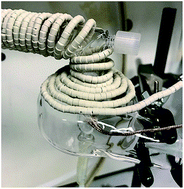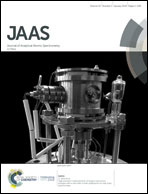Infrared heating of the top surface of a cyclonic spray chamber to improve the analytical performance of inductively coupled plasma optical emission spectrometry
Abstract
This study investigates how the figures of merit of inductively coupled plasma optical emission spectrometry can be improved by heating the top part of a cyclonic spray chamber. A ceramic beaded infrared (IR) rope heater was used to heat the top surface of a quartz baffled cyclonic spray chamber, side arm of the spray chamber, elbow connection to the torch and base of the torch up to 150 °C. A PFA nebulizer was utilized for all measurements. Optimum operating conditions were selected using multivariate optimizations for 21 elements. Upon IR heating, transport efficiency was significantly enhanced from 4.5% at room temperature to 15.7% at 150 °C. This improved sensitivity by 3.0 to 4.9 fold, depending on the element, and detection limit by 3.7 to 12 fold compared to those with the same sample introduction system at room temperature. The plasma robustness was also improved as assessed by Mg II 280.270/Mg I 285.213 nm ratios of 9 at room temperature and 11 at 150 °C. Accuracy was not jeopardized with IR heating, as similar results were obtained without and with IR heating for the elemental analyses of two certified reference materials of drinking and waste waters using a simple external calibration without internal standardization or matrix-matching.



 Please wait while we load your content...
Please wait while we load your content...